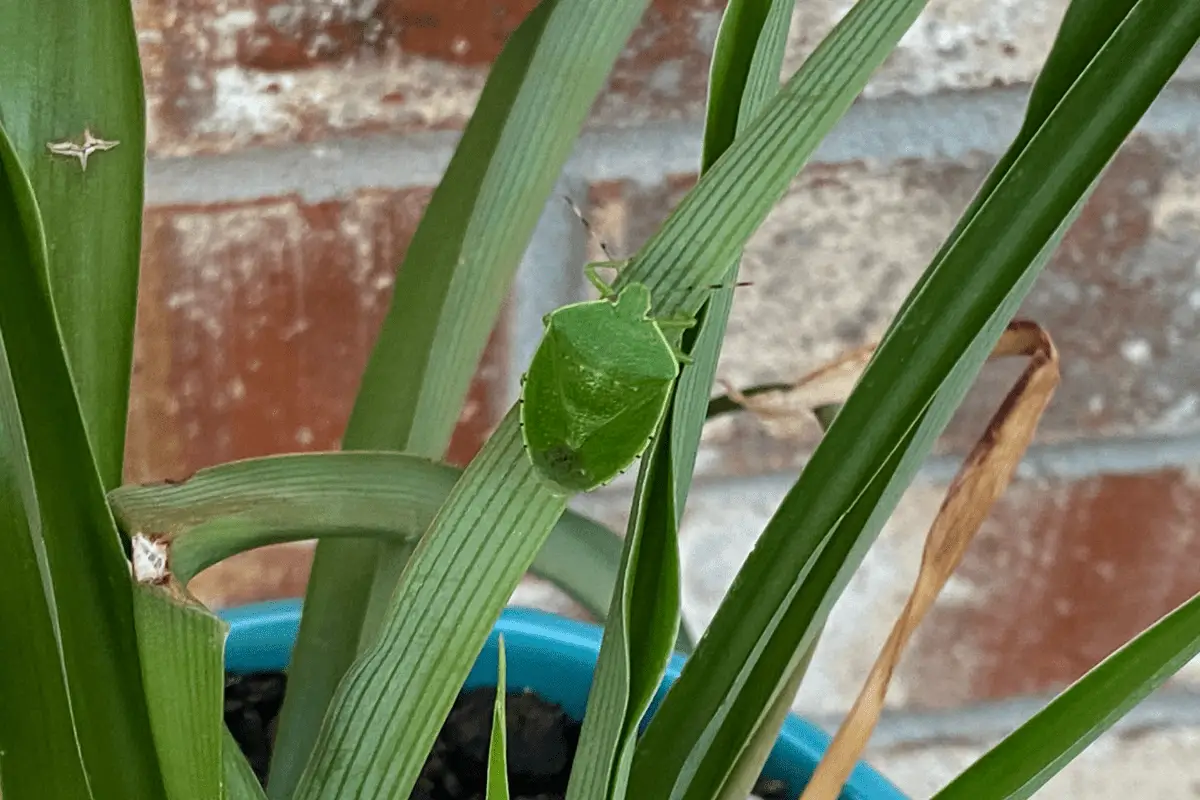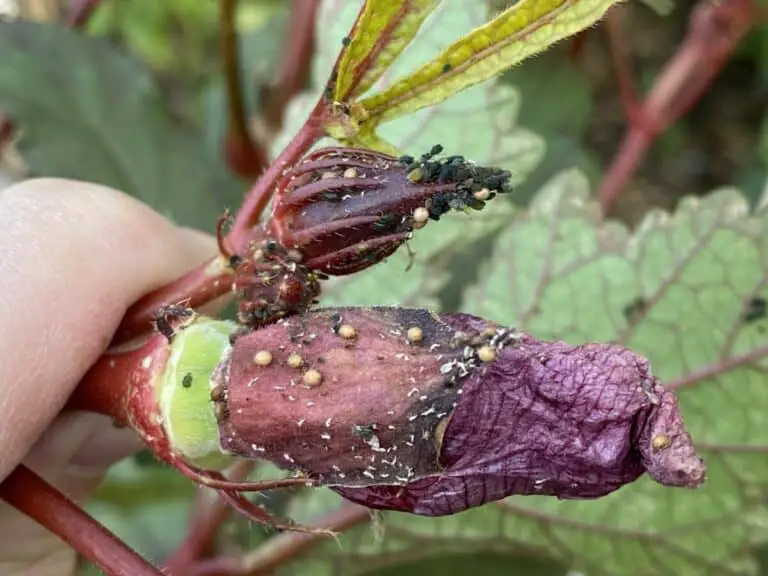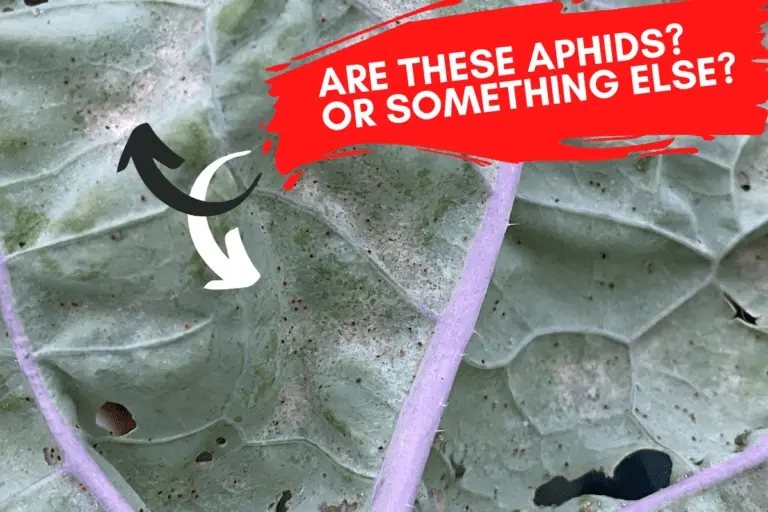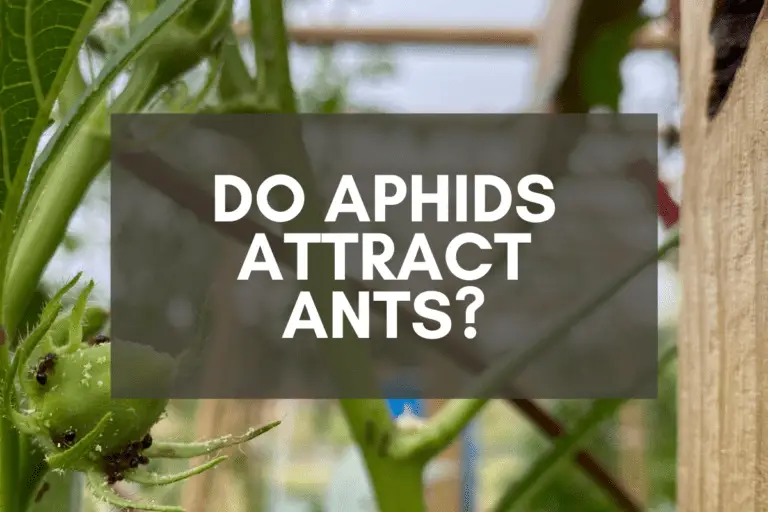Killing Stink Bugs with Neem Oil: Does It Work?
Whether you’ve just started gardening or have been doing so for years, you’ve probably heard of stink bugs even if you haven’t yet seen one in your garden.
Stink bugs are members of the Pentatomidae family. They come in all kinds of sizes and colors–the most common being brown, black, red, and green–and you can identify them based on their shield-like exoskeletons. With more than 4,700 species spread across the world, they’ve become a global pest and a major nuisance to farmers and gardeners alike.
When it comes to other nasty global pests (like aphids and spider mites), I use insecticidal soap and neem oil to get rid of them. But what about stink bugs? Will neem oil harm or kill off stink bugs?
Neem oil is relatively ineffective when it comes to killing stink bugs. Although it’s been shown to reduce feeding rates, increase egg mortality, and produce wing and leg malformations, neem oil doesn’t work well on stink bugs since both nymphs and adults can tolerate its chemical compounds.
Just to be clear: I’m not saying that neem oil does nothing to stink bugs because the research that’s out there is pretty clear that it can have some beneficial effects on these insects. It just won’t kill them off the way it’ll kill off aphids, armyworms, spider mites, whiteflies, and other soft-bodied insects.
This is good news for stink bugs but bad news for those of us who want to keep our gardens free of such pests but also wish to avoid using harsh chemical insecticides on or around our plants.
So is there nothing to be done when stink bugs show up in your garden?
Actually, there are several benefits to using neem oil and a few key strategies you can adopt to rid your garden of stink bugs.
Can You Use Neem Oil to Kill Stink Bugs?
At first glance, neem oil would seem like a perfect product to use if you’ve found stink bugs in your garden.
It’s been shown to kill off over 200 kinds of pests, yet it’s safe to use on fruits and vegetables (even days before a harvest), and it won’t harm earthworms, ladybugs, beneficial nematodes, or bees, butterflies, and other pollinators.
Much like other pests, stink bugs use their piercing mouthparts (known as proboscis) to puncture plant material and siphon off plant’s vital nutrients. But unlike spider mites, they’ll do this to both leafy material as well as veggies and fruits, causing everything from minor blemishes to ugly rotting spots as well as disease transmission.
What’s confusing for so many gardeners is that neem oil generally kills off plant-piercing bugs in 4-7 days. When properly mixed and applied to plants, neem oil’s primary chemical compounds (including the powerful natural chemical azadirachtin) find their way into bugs’ bodies and begin causing all kinds of cellular damage.
Unfortunately, even though stink bugs intake neem oil when they attack plants with their proboscis, the chemical compounds don’t do to them what they do to so many other bugs.

Before we look at several effectives ways to remove stink bugs from your garden–including my personal preferred approach–let’s take a moment to see what scientists who’ve experimented with neem oil on stink bugs have learned.
I want to share this information for 2 reasons. First, I’ve seen too many writers suggest, without evidence, that using neem oil is an effective solution to stink bugs. Second, I’ve seen a handful of other writers suggest, again without evidence, that neem oil will have little to no effect on stink bugs.
So let’s take a look at what scientists have actually learned about neem oil and stink bugs. There aren’t a ton of published studies out there, but there’s enough to give us a sense of what scientists have learned about neem oil and stink bugs.
- In an important study, researchers looked at a broad range of pest management products to see which, if any, killed off the brown marmorated stink bug (Pentatoma halys Stål), a particularly destructive global pest that originated in Southeast Asia but migrated to the United States around 1998, then on to South America and Europe. The researchers tried just about everything on these bugs–acetamiprid, carbaryl, essential oils, neem oil, permethrin, petroleum oil, potassium salts, and spinosad–and found that chemical insecticides increased the mortality rates of eggs, nymphs, and adults alike to differing degrees. Essential oils and spinosad were effective against nymphs only. Unfortunately, neem oil only increased the mortality rates of eggs. It had no effect on nymph or adult stink bugs.
- Another study looked at neem’s impact on the lychee stink bug (Tessaratoma papillosa) and determined that, in general, neem oil led to reduced feeding among lychee stink bugs and thus increased their mortality rates, especially when applied at higher doses.
- A team of researchers examined neem oil’s impact on the small rice stink bug (Oebalus poecilus) and found that neem oil reduced the overall feeding behaviors of these stink bugs and thereby resulted in less crop loss. But neem oil only killed off stink bugs when applied in very high concentrations.
- In a study that looked at how neem oil impacted the southern green stink bug (Nezara viridula), the researchers didn’t note any reduction in stink bug population levels, but they found that neem oil drastically reduced feeding behaviors in both female and male stink bugs.
Here’s one final study that’s worth noting: Researchers have found that neem oil works well on a species of stink bug known as spined soldier bugs (Podisus nigrispinus). It inhibits its growth, shortens its lifespan, and increases the mortality rates of both nymphs and adults.
But this is actually bad news for gardeners since spined soldier bugs are one of the few stink bug species that are surprisingly beneficial.
Unlike most stink bugs, spined soldier bugs don’t attack plants. They go after various destructive pests: armyworms, cabbage loopers, corn earworms, Mexican bean beetles, and Colorado potato beetles, to name a few. Unfortunately, it’s hard to tell the difference between spined soldier bugs and brown marmorated stink bugs.
Check out this article from researchers at the University of Kentucky if you’d like to learn more about what differentiates spined soldier bugs from other stink bugs.
Although the available research on neem oil and stink bugs is very limited–given the fact that different species of stink bug seem to react in somewhat different ways to neem oil applications–I hope the evidence presented above gives you a more accurate picture of what might happen if you spray neem oil on stink bug infested plants.
Is neem oil completely worthless when used on stink bugs? No. But will it take care of your stink bug problems? Probably not.
Long story short, neem oil will likely reduce stink bug feeding patterns–and possibly increase the mortality rate of stink bug eggs–but it’s unlikely to rid your garden of stink bugs.
If you intend to use neem oil to stave off garden pests, be sure to follow these recommendations and avoid these common problems. You’ll also want to take care when using neem oil anywhere near seedlings, herbs, or other delicate, wispy plants because it’s easy to burn plants if you use neem oil incorrectly.
What’s the Best Natural Way to Kill Stink Bugs?
Now that I’ve covered the upsides and downsides of using neem oil on stink bugs, let’s look at several approaches you can take to naturally kill off stink bugs in your garden.
One word of caution: These approaches are primarily for gardeners and gardening hobbyists. Those who own big farms or engage in large-scale agricultural production might need to turn to chemical insecticides (such as permethrins) since the natural approaches I advocate below are great for gardeners but likely much too time-intensive if you’ve got acres upon acres of infested veggies.
Also, I’ve seen several people suggest the use of diatomaceous earth or homemade sprays made up of essential oils, garlic, or vinegar, but in general, I find those methods less effective then the ones I’ve listed below:
1. Squash Them with Your Hand
This is the most natural method you can use with stink bugs–and also the stickiest and most inefficient.
If you see stink bugs in your garden, put on a thick pair of gloves and move quickly to either crush them in your fist or smash them between two hands.
They’ll do their best to move away from you, but unlike leaf-footed bugs, which will sometimes take flight, I find that stink bugs often simply try to crawl away. If you’re quick with your hands, you’ll get them most of the time.
But as you can imagine, this is a somewhat gross and time-consuming way to get rid of stink bugs. Just make sure your gloves have water resistant padding of some kind; otherwise, those bug juices will make it through the material and into your hands after you’ve crushed a few insects.
2. Knock Them Into Soapy Water
This is a cleaner version of method #1. Instead of squishing stink bugs manually, what you’re attempting to do here is to knock them off the plants and into a small bowl of soapy water.
Please note that you’ll need to pay close attention to the container. I suggest using something small and narrow that you can hold in your less dominant hand. That way, you can use your dominant hand to grab stink bugs or knock them off the plant and into the soapy water and your less dominant hand to hold the container so that they fall directly into it.
Unfortunately, this only works if you have easy access to the bugs and can either grab them or knock them off the plant. If you’ve got thick plants and lots of branches in between you and the stink bugs, you’re probably not going to be very successful using this method.
3. Spray Them with Insecticidal Soap
As noted above, the study on brown marmorated stink bugs suggested that there’s some value to insecticidal soap treatments since the soapy water seems to choke off the bug’s ability to feed and breathe properly (both adults and nymphs) while also damaging stink bugs eggs, thus contributing to an overall increase in stink bug mortality rates.
For most insecticidal soaps, I use a very simple recipe: 1 gallon water + 5 tablespoons of Dr. Bronner’s Peppermint Castile Soap. I explain my recipe in more detail in my article that discusses using neem oil on herbs.
But for stink bugs, I prefer to make my insecticidal soap spray with another product: Safer Brand Insect Killing Soap. This is a more potent soap and very similar to the kind of soap used in the above study on brown marmorated stink bugs.
This soap works best when mixed according to package directions and sprayed directly on stink bugs. I suggest using an insecticidal soap spray later in the day–preferably as the sun is setting–so that there’s less of a chance of accidentally spraying it on bees, butterflies, or other beneficial pollinators since it wil likely kill them.

4. Use a Hand Vacuum to Suck Them Up (My Preferred Method)
This is, by far, my favorite method when it comes to natural stink bug control. It’s the most time efficient, the least messy, and the most satisfying.
Here’s what you’ll need to do:
Purchase a hand vacuum (if you don’t already have one). I use this Black and Decker model, and I love it! It’s strong enough to suck up bugs but weak enough so that it doesn’t damage my plants.
Go out into your garden with your hand vacuum each day and look for stinks bugs. Whenever you see one, turn on your vacuum, push the nozzle close to the stink bug, and rub the nozzle a bit to dislodge it. Most bugs will try to cling to the plant but will be unable to do so once you dislodge them with the muzzle of your hand vacuum. They’ll then be sucked up into the vaccum’s trash canister.
Continue sucking up bugs until you’ve either caught them all for the day or you’ve mostly filled your canister with them. You don’t have to limit yourself to stink bugs either. I’ve found that the hand vacuum is also a great solution for cucumber beetles, harlequin beetles, leaf-footed bugs, and squash bugs.
Option 1: If there are more bugs to kill, you’ll need to empty the canister and kill the bugs that are inside so that you can keep using the vacuum. I recommend grabbing a brick and walking over to a less traveled corner of your property. Detach the canister from the vacuum and lightly bang it on the ground to get the bugs to fall out. They’ll be momentarily fazed, and in that moment, you can smash them with a brick. Wear gloves and hit the pile of bugs repeatedly until there’s no longer any movement. This might seem kind of gross the first time or two that you do it, but after that, it’ll be no big deal.
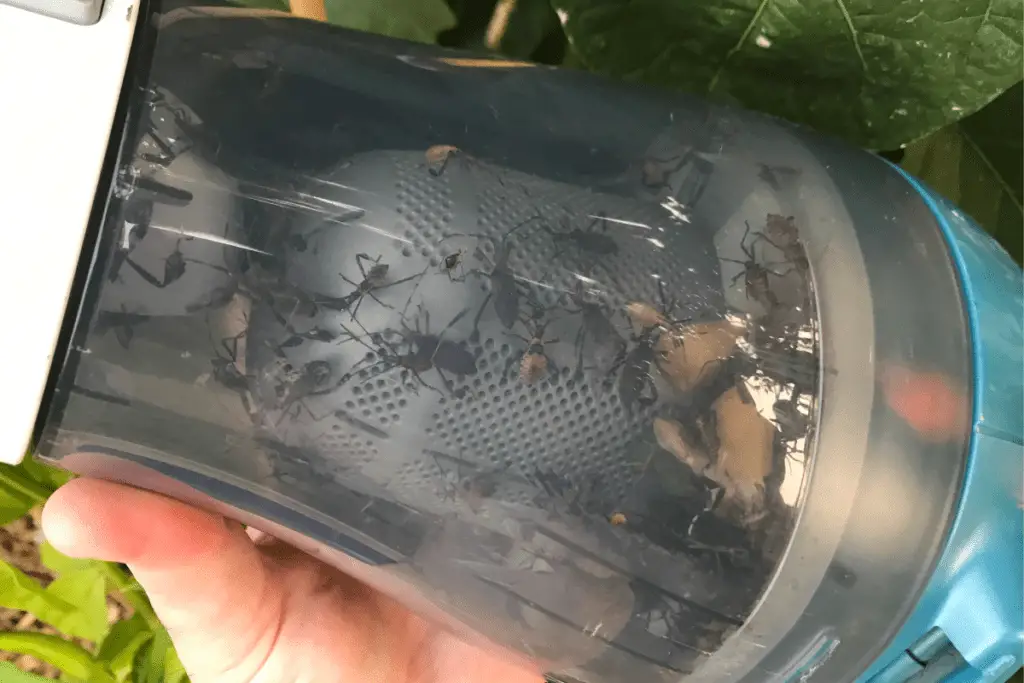
Option 2: If you’ve caught all of the visible bugs in your garden–and assuming your hand vacuum has a door that traps everything in the canister (and most of them have something like this)–simply leave your vacuum overnight in a safe place outside your home, like a garage, storage shed, or patio. When you take a look the next day, most (if not all) of the bugs will be dead since they’ve had no access to food for 12 or so hours. You can then shake the canister into the trash can, which means you won’t have to worry about smashing bugs with a brick.
As you’ve seen in the information and recommendations above, neem oil is an option when it comes to stink bugs, primarily to prevent feeding behavior, but it’s not a solution that’ll solve stink bug infestations, so what I recommend most is everyday diligence, insecticidal soap spray (whenever necessary), and lots and lots of vacuuming.
If you go out into your garden with your hand vacuum every day and vacuum up every stink bug you see, you’ll be amazed at what you can accomplish in as little as a week.
Additional Information
I recommend taking a look at these articles if you’d like to know more about using neem oil in your garden:
